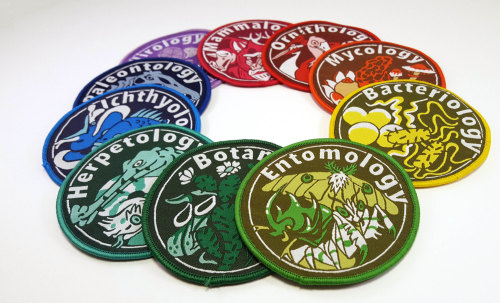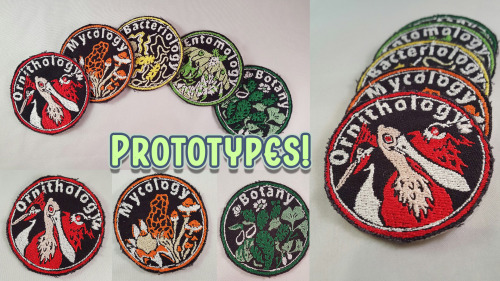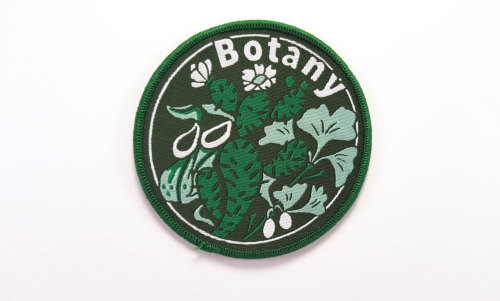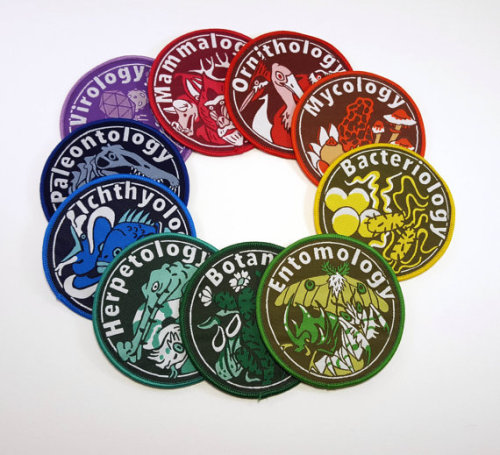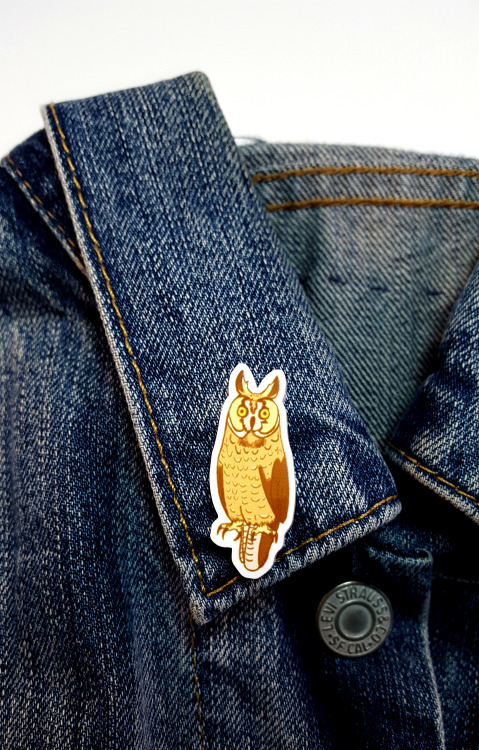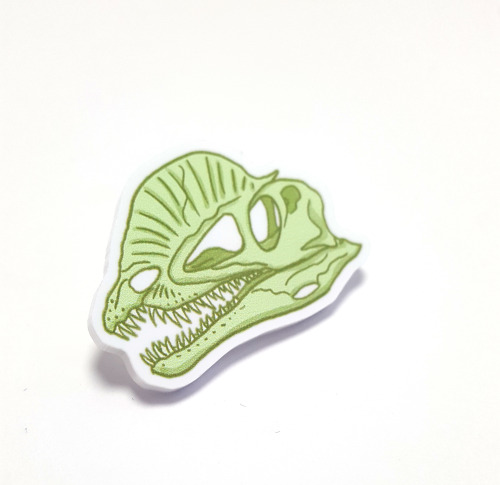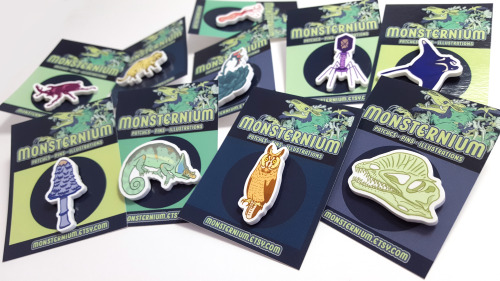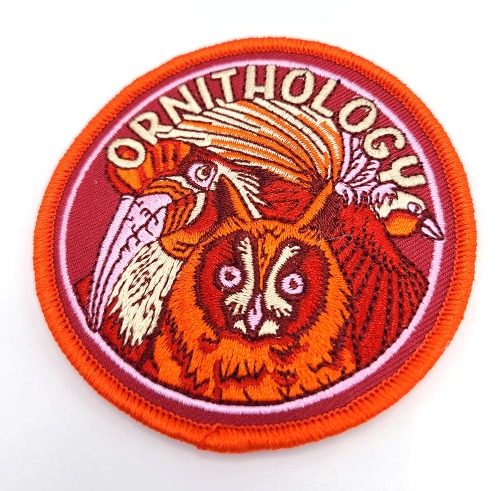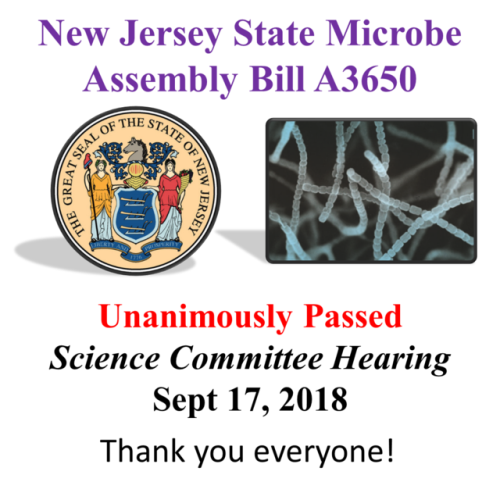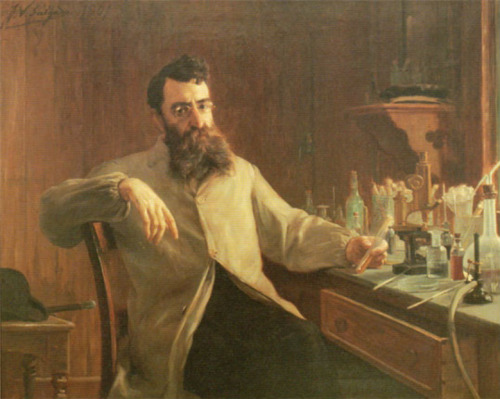#bacteriology
BIG UPDATE!
I’ve finally finished my biological patches set! After many months of designing, editing, and trial and error, I’m proud to post up photos of the final products!
They are woven with bright, beautiful colors that will endure many washes and adventures to come. They’re only $8 in my store:
https://www.etsy.com/shop/Monsternium
Here are the first five patches in my biological patch set. Once all ten are made, the rainbow of studies will be complete! Each one is illustrated, digitized, and embroidered by me. Stay tuned for more! Next up is herpetology ;)Reblogging this post for the update!
Reblogging again for yet another update! Newly added: Arachnology.
All the designs have been redrawn, new creatures picked. Super happy with these!
Available now in my shop:
https://www.etsy.com/shop/Monsternium
Post link
Latest additions to my Monsternium store:
1.5″ Printed Acrylic Pins!
$6 each- Get them here!
In the first photo, going clockwise:
African Civet, Long-Eared Owl, Heliobacter Pylori, Japanese Rhinoceros Beetle, Bacteriophage, Manta Ray, Shaggy Mane Mushroom, Echeveria Succulent, Parson’s Chameleon, and a Dilophosaurus Skull.
It was really cool to see how @acornpress took my drawings and turned them into fun little charms. I wanted to come up with a set of pins that sort of coincided with my biological patches set, so I chose favorites from the ten disciplines and voila- cute, bright, little pins!
Post link
BIG UPDATE!
I’ve finally finished my biological patches set! After many months of designing, editing, and trial and error, I’m proud to post up photos of the final products!
They are woven with bright, beautiful colors that will endure many washes and adventures to come. They’re only $8 in my store:
https://www.etsy.com/shop/Monsternium
Here are the first five patches in my biological patch set. Once all ten are made, the rainbow of studies will be complete! Each one is illustrated, digitized, and embroidered by me. Stay tuned for more! Next up is herpetology ;)
Reblogging this post for the update!
Post link
BIG UPDATE!
I’ve finally finished my biological patches set! After many months of designing, editing, and trial and error, I’m proud to post up photos of the final products!
They are embroidered with bright, beautiful colors that will endure many washes and adventures to come. They’re only $8 in my store:
https://www.etsy.com/shop/Monsternium
Here are the first five patches in my biological patch set. Once all ten are made, the rainbow of studies will be complete! Each one is illustrated, digitized, and embroidered by me. Stay tuned for more! Next up is herpetology ;)
Post link
New Jersey State Microbe Approved by Assembly
On February 25, 2019 The NJ Assembly unanimously voted in favor of designating an Official State Microbe, Streptomyces griseus. This brings NJ one step closer to being the second state in the US (and the world) to have a symbolic microbe.
This action sequence shows me (seated) casting the vote for Assemblywoman Annette Quijano (standing) in the Assembly Chamber. Wow, that was cool, and an honor! ASW Quijano was the principal sponsor in the Assembly. The vote was 76 to zero.
Strep griseus produces streptomycin, the first broad spectrum antibiotic and the first significant antibiotic found in America. It was discovered in 1943 in New Brunswick, NJ
Talk about pressure “Don’t press the red button!”
Please read my amazing microbiology book: https://tinyurl.com/Warhol-Small-Guide
More info:https://en.wikipedia.org/wiki/State_microbe
Post link
The NJ Microbe had another milestone when the Assembly Science, Innovation, and Technology all voted in favor of the bill.
Thank you to all the people from around the world who contacted the legislators on behalf of the microbe.Thank you to the Assembly members who voted for it and all the bill’s sponsors.
For a great science book:https://tinyurl.com/Warhol-Small-Guide It costs less than a burger and a Coke, it lasts longer, and is more fun!
Post link
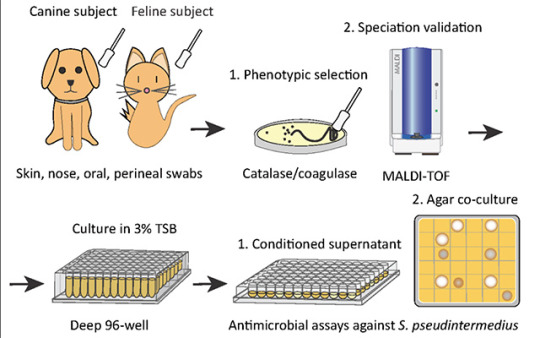
Researchers identify a bacteria on healthy cats that produces antibiotics against severe skin infections; the findings may lead to new bacteriotherapies for humans and their pets
Researchers at University of California San Diego School of Medicine used bacteria found on healthy cats to successfully treat a skin infection on mice. These bacteria may serve as the basis for new therapeutics against severe skin infections in humans, dogs and cats.
The study, published in eLife on October 19, 2021, was led by Richard L. Gallo, MD, PhD, Distinguished Professor and chair of the Department of Dermatology at UC San Diego School of Medicine, whose team specializes in using bacteria and their products to treat illnesses — an approach known as “bacteriotherapy.”
Skin is colonized by hundreds of bacterial species that play important roles in skin health, immunity and fighting infection. All species need to maintain a diverse balance of healthy skin bacteria to fight potential pathogens.
“Our health absolutely depends on these ‘good’ bacteria,” said Gallo. “They rely on our healthy skin to live, and in return some of them protect us from ‘bad’ bacteria. But if we get sick, ‘bad’ bacteria can take advantage of our weakened defenses and cause infection.”
This is the case with methicillin-resistant Staphylococcus pseudintermedius (MRSP), a bacterium commonly found on domesticated animals that becomes infectious when the animals are sick or injured. MRSP is an emerging pathogen that can jump between species and cause severe atopic dermatitis, or eczema. These infections are common in dogs and cats, and can also occur in humans, though rates of human infection vary around the world. As its name suggests, MRSP is resistant to common antibiotics and has been difficult to treat in clinical and veterinary settings.
To address this, researchers first screened a library of bacteria that normally live on dogs and cats and grew them in the presence of MRSP. From this, they identified a strain of cat bacteria called Staphylococcus felis(S. felis) that was especially good at inhibiting MRSP growth. They found that this special strain of S. felis naturally produces multiple antibiotics that kill MRSP by disrupting its cell wall and increasing the production of toxic free radicals.
“The potency of this species is extreme,” said Gallo. “It is strongly capable of killing pathogens, in part because it attacks them from many sides — a strategy known as ‘polypharmacy.’ This makes it particularly attractive as a therapeutic.”
Bacteria can easily develop resistance to a single antibiotic. To get around this, S. felis has four genes that code for four distinct antimicrobial peptides. Each of these antibiotics is capable of killing MRSP on their own, but by working together, they make it more difficult for the bacteria to fight back.
Having established how S. felis kills the MRSP, the next step was to see whether it could work as a therapy on a live animal. The team exposed mice to the most common form of the pathogen and then added either S. felis bacteria or bacterial extract to the same site. The skin showed a reduction in scaling and redness after either treatment, compared with animals that had no treatment. There were also fewer viable MRSP bacteria left on the skin after treatment with S. felis.
Next steps include plans for a clinical trial to confirm whether S. felis can be used to treat MRSP infections in dogs. Bacteriotherapies like this one can be delivered via topical sprays, creams or gels that contain either live bacteria or purified extract of the antimicrobial peptides.
Pictured above: To identify candidates for a new bacteriotherapy against skin infection, researchers first screened various bacteria from dogs and cats and co-cultured them with S. pseudintermedius in liquid and agar antimicrobial assays.
“Cat Bacteria Treats Mouse Skin Infection, May Help You and Your Pets As Well”
Portrait of physician, epidemiologist, and bacteriologist Ricardo Jorge (1858–1939) — Veloso Salgado, 1901 (Porto Municipal Public Library)
Post link
Meet Dr. Fe Villanueva del Mundo, a well-renowned Filipina pediatrician who started the first pediatric clinic in the Philippines.
.
After graduating as valedictorian from the University of the Philippines with her medical degree in 1926, Dr. del Mundo was offered an amazing opportunity. President Manuel Quezon offered to pay for her studies in any field at any institution in the United States.
.
Not missing the chance, Dr. del Mundo furthered her education at the Children’s Hospital in Boston and Harvard Medical School where she completed her fellowship in 1939 as well as earning a master’s degree in Bacteriology at Boston University’s School of Medicine in 1940.
.
She returned to the Philippines in 1941, just before the Japanese invasion. As battles erupted, del Mundo cared for children as part of the international Red Cross and also helped form a makeshift hospice inside an internment camp.
.
Outside of establishing a children’s hospital in 1943 (after the Japanese disbanded the hospice), Dr. del Mundo is also known for her research on infectious diseases (such as dengue virus) and how they affect children.
.
And if that isn’t impressive enough, del Mundo is also known for creating an incubator out of bamboo that could be used in areas without electricity.
.
As such, Dr. Del Mundo has been given numerous awards for her service to mankind and it is our honor to pay tribute to this phenomenal woman.
.
.
#womeninscience #womeninstem #womeninmedicine #filipina #philippines #pediatrics #bacteriology #dengue #art #digitalart #digitalillustration #fedelmundo #jkxcomics
https://www.instagram.com/p/BvCeoY-BbnO/?utm_source=ig_tumblr_share&igshid=zzc8ecmhmp7h
Post link
1. Mycobacterium tuberculosis - Stops fusion!

Mycobacterium tuberculosis utilizes macrophages for its replication! (It uses the usual killer to expand it’s army :O ) How does tuberculosis bacilli survive in macrophages? M. tuberculosis has evolved a number of very effective survival strategies - It inhibits phagosome-lysosome fusion and inhibits phagosome acidification ensuring it’s survival inside the macrophage.
2. Brucella - Has chains, like Bruce Lee.

Brucellahas a LPS O-chain. It ensures the Brucella containing vacuole (BCV) avoids fusion with lysosomes, prevents the deposition of complement at the bacterial surface and forms stable large clusters with MHC-II named macrodomians in the cell surface, interfering with MHC-II presentation of peptides to specific CD4+ T cells. Woah.
3. Listeria - It gets internalized in a vacuole and then runs away.

The pore-forming protein listeriolysin O mediates escape from host vacuoles. Once in the cytosol, the L. monocytogenes mediates efficient actin-based motility, thereby propelling the bacteria into neighboring cells. The cytosol is a favorable environment for listeria’s growth.
4. Mycobacterium leprae - Cholesterol and TACO!

Mycobacterium leprae is able to induce lipid droplet formation in infected macrophages. Cholesterol mediates the recruitment of TACO from the plasma membrane to the phagosome. TACO, also termed as coronin-1A (CORO1A), is a coat protein that prevents phagosome-lysosome fusion and thus degradation of mycobacteria in lysosomes. The entering of mycobacteria at cholesterol-rich domains of the plasma membrane and their subsequent uptake in TACO-coated phagosomes promotes intracellular survival.
5. Coxiella brunetti - The indestrucible

This hardy, obligate intracellular pathogen has evolved to not only survive, but to thrive, in the harshest of intracellular compartments: the phagolysosome. Following internalization, the nascent Coxiella phagosome ultimately develops into a large and spacious parasitophorous vacuole (PV) that acquires lysosomal characteristics such as acidic pH, acid hydrolases and cationic peptides, defences designed to rid the host of intruders.
6. Salmonella - TTSS

Salmonella have a specialized secretion system, termed the type III secretion system (TTSS), as well as proteins secreted by this system, are encoded in Salmonella pathogenicity island 1 (SPI1). TTSS are used by bacterial pathogens to inhibit their phagocytosis, induce eukaryotic cell death, and alter the host cell cytoskeleton. Salmonella species have at least one other TTSS encoded on SPI2 that appears to be involved in intracellular survival.
7. Human Immunodeficiency Virus - Tries to not attract attention

After infecting cells, HIV survives. Ever wondered why? It’s because the HIV protein, Nef plays a role in downregulating the expression of various proteins needed for recognition by potentially dangerous CD8 T cells. Nef lowers the surface expression of CD4, and several haplotypes of MHC-I by redirecting their transport from the trans-Golgi network. Another gene, Tat, appears to upregulate the expression of Bcl-2 during the early phase of cellular infection, increasing the likelihood that it will receive survival signals.
Many viruses can survive intracellularly, but I’ve included specifically HIV in this list because it survives in immune cells and it is an important virus to know.
1. Mycoplasma - They are devoid of cell walls.

Yup. They lack cell wall precursors like muramic acid. No fixed shape or size. You could easily mistake mycoplasma for a virus, they even pass through bacterial filters!
2. Actinomycetes - They look like fungi!

I mean, the only reason we consider it as a bacteria is because it contains muramic acid in it’s cell wall. Otherwise, those branching filaments scream the word, fungi!
3. Chlamydiae - Obligate intracellular parasite. Are you a virus?

They fail to grow in cell free media, they get filtered in bacterial filters. Why are you called a bacteria, anyway? Well, they do have DNA, RNA, ribosomes and replicate by binary fission.. So let’s count the poor energy parasite as a bacteria.
4. Mycobacteria - Here’s another rod shaped bacteria that sometimes shows filamentous forms resembling fungal mycelium.

So let’s call it ‘mycobacteria’, you know, fungus like bacteria!
Unlike you regular gram positive and gram negative bacteria, they are acid fast.
Related posts:
Cell wall of gram positive and gram negative bacteria mnemonic
Mycobacterial biochemical reactions mnemonic
1. It produces golden yellow colonies.

Gold is royal.
2. They have the ability to develop resistance to every antibiotic you can think of.

Penicillin, methicillin, vancomycin. You name it.
3. It’s the bacteria you think of when you see a bunch of grapes.

Because, grape like clusters!
4. They turn pink due to lactose fermentation on MacConkey’s agar.

Whoever said orange was the new pink was seriously disturbed!
5. TSST will leave you shocked.

It’s called toxic shock syndrome toxin for a reason, duh!
6. Fastest enterotoxin ever.

Vomiting, diarrhea and nausea 2-6 hours after consuming contaminated food? Now that’s quick.

Who doesn’t like cats?

